Policy Development: Reducing Chronic Ailments and Healthcare Costs
VerifiedAdded on 2023/04/21
|8
|1706
|293
Report
AI Summary
This report addresses the escalating issue of chronic ailments and their substantial impact on healthcare costs within the United States. The author highlights the increasing life expectancy coupled with a decline in the quality of life due to chronic conditions, emphasizing the role of lifestyle factors, such as poor diet, sedentary habits, and substance use. The core of the report proposes a comprehensive policy framework involving healthcare professionals, educational institutions, community centers, and governmental bodies to promote preventive measures, health education, and lifestyle modifications. The policy suggests strategies like health promotion programs, integration of health studies in school curriculums, community-based screening, and the regulation of unhealthy food advertisements. The expected outcomes include reduced healthcare spending, decreased workload for healthcare providers, and improved overall health outcomes, fostering a healthier and more informed citizenry. The author provides references to support the arguments made throughout the report.
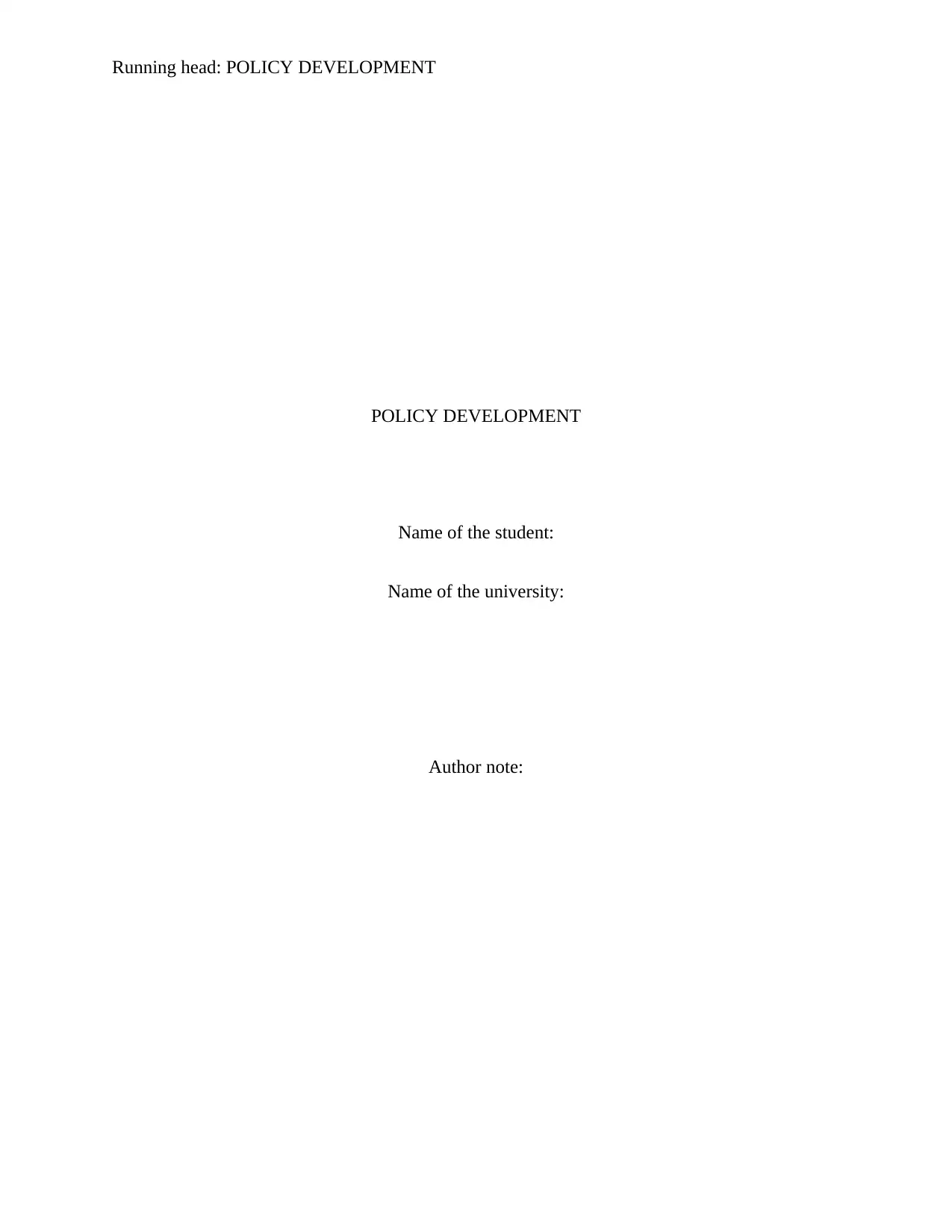
Running head: POLICY DEVELOPMENT
POLICY DEVELOPMENT
Name of the student:
Name of the university:
Author note:
POLICY DEVELOPMENT
Name of the student:
Name of the university:
Author note:
Paraphrase This Document
Need a fresh take? Get an instant paraphrase of this document with our AI Paraphraser
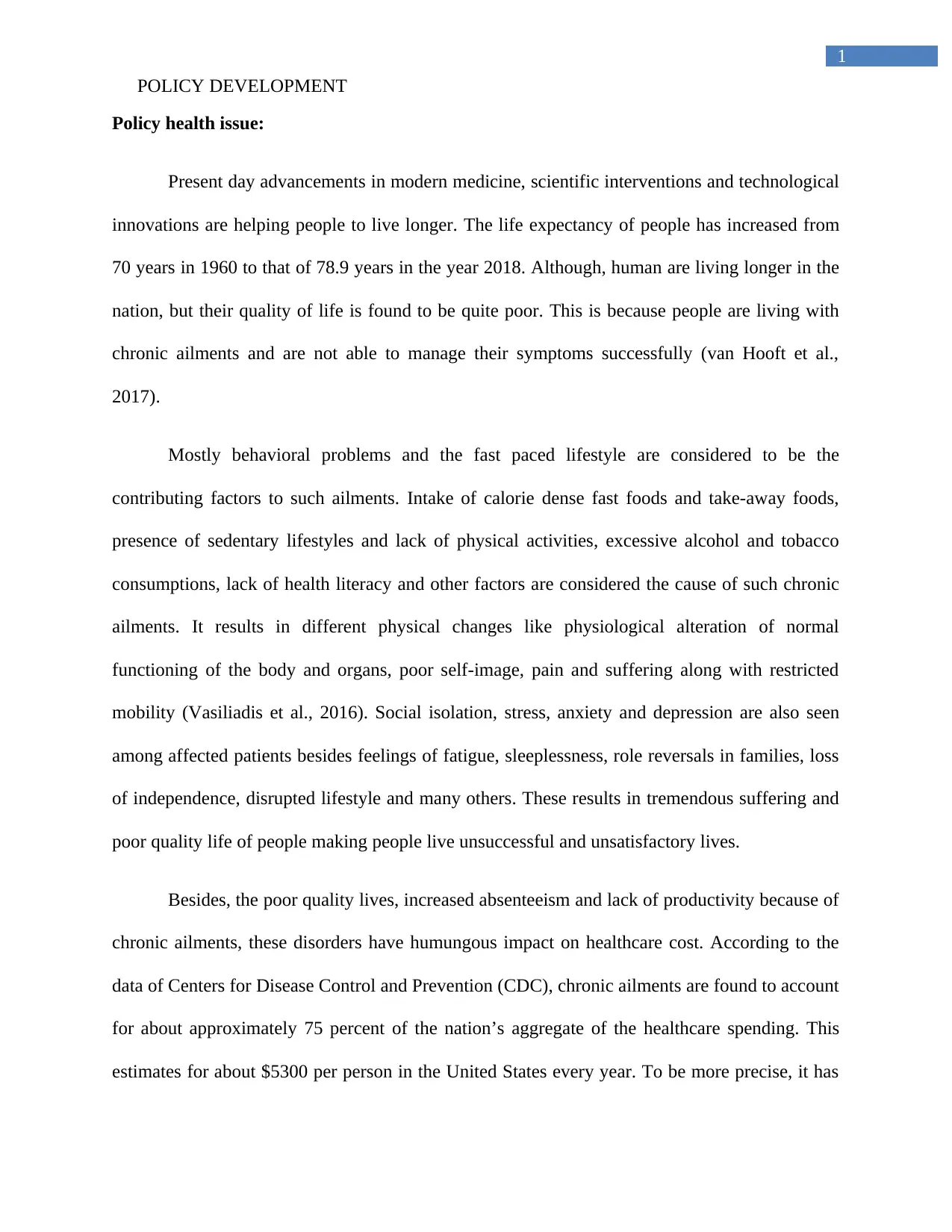
1
POLICY DEVELOPMENT
Policy health issue:
Present day advancements in modern medicine, scientific interventions and technological
innovations are helping people to live longer. The life expectancy of people has increased from
70 years in 1960 to that of 78.9 years in the year 2018. Although, human are living longer in the
nation, but their quality of life is found to be quite poor. This is because people are living with
chronic ailments and are not able to manage their symptoms successfully (van Hooft et al.,
2017).
Mostly behavioral problems and the fast paced lifestyle are considered to be the
contributing factors to such ailments. Intake of calorie dense fast foods and take-away foods,
presence of sedentary lifestyles and lack of physical activities, excessive alcohol and tobacco
consumptions, lack of health literacy and other factors are considered the cause of such chronic
ailments. It results in different physical changes like physiological alteration of normal
functioning of the body and organs, poor self-image, pain and suffering along with restricted
mobility (Vasiliadis et al., 2016). Social isolation, stress, anxiety and depression are also seen
among affected patients besides feelings of fatigue, sleeplessness, role reversals in families, loss
of independence, disrupted lifestyle and many others. These results in tremendous suffering and
poor quality life of people making people live unsuccessful and unsatisfactory lives.
Besides, the poor quality lives, increased absenteeism and lack of productivity because of
chronic ailments, these disorders have humungous impact on healthcare cost. According to the
data of Centers for Disease Control and Prevention (CDC), chronic ailments are found to account
for about approximately 75 percent of the nation’s aggregate of the healthcare spending. This
estimates for about $5300 per person in the United States every year. To be more precise, it has
POLICY DEVELOPMENT
Policy health issue:
Present day advancements in modern medicine, scientific interventions and technological
innovations are helping people to live longer. The life expectancy of people has increased from
70 years in 1960 to that of 78.9 years in the year 2018. Although, human are living longer in the
nation, but their quality of life is found to be quite poor. This is because people are living with
chronic ailments and are not able to manage their symptoms successfully (van Hooft et al.,
2017).
Mostly behavioral problems and the fast paced lifestyle are considered to be the
contributing factors to such ailments. Intake of calorie dense fast foods and take-away foods,
presence of sedentary lifestyles and lack of physical activities, excessive alcohol and tobacco
consumptions, lack of health literacy and other factors are considered the cause of such chronic
ailments. It results in different physical changes like physiological alteration of normal
functioning of the body and organs, poor self-image, pain and suffering along with restricted
mobility (Vasiliadis et al., 2016). Social isolation, stress, anxiety and depression are also seen
among affected patients besides feelings of fatigue, sleeplessness, role reversals in families, loss
of independence, disrupted lifestyle and many others. These results in tremendous suffering and
poor quality life of people making people live unsuccessful and unsatisfactory lives.
Besides, the poor quality lives, increased absenteeism and lack of productivity because of
chronic ailments, these disorders have humungous impact on healthcare cost. According to the
data of Centers for Disease Control and Prevention (CDC), chronic ailments are found to account
for about approximately 75 percent of the nation’s aggregate of the healthcare spending. This
estimates for about $5300 per person in the United States every year. To be more precise, it has
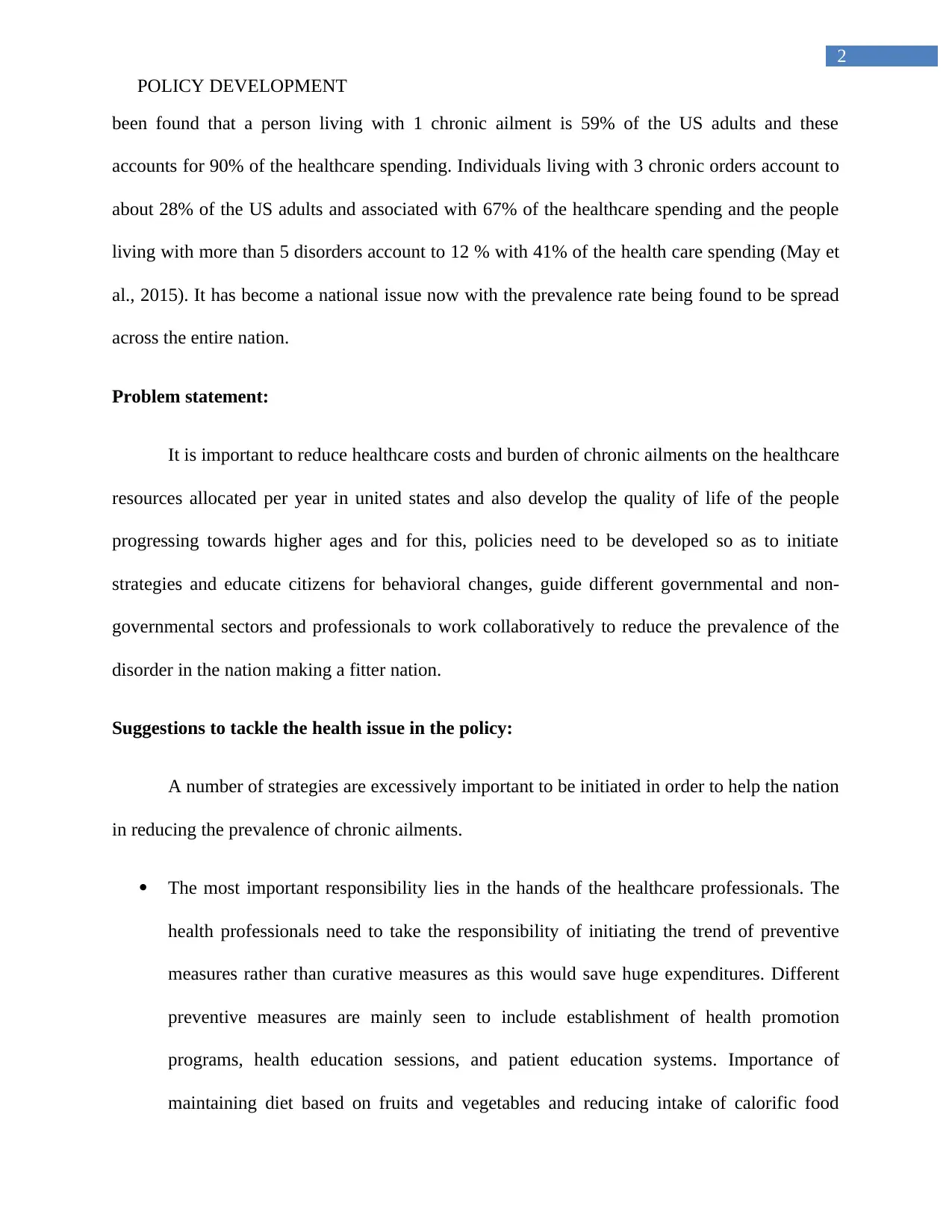
2
POLICY DEVELOPMENT
been found that a person living with 1 chronic ailment is 59% of the US adults and these
accounts for 90% of the healthcare spending. Individuals living with 3 chronic orders account to
about 28% of the US adults and associated with 67% of the healthcare spending and the people
living with more than 5 disorders account to 12 % with 41% of the health care spending (May et
al., 2015). It has become a national issue now with the prevalence rate being found to be spread
across the entire nation.
Problem statement:
It is important to reduce healthcare costs and burden of chronic ailments on the healthcare
resources allocated per year in united states and also develop the quality of life of the people
progressing towards higher ages and for this, policies need to be developed so as to initiate
strategies and educate citizens for behavioral changes, guide different governmental and non-
governmental sectors and professionals to work collaboratively to reduce the prevalence of the
disorder in the nation making a fitter nation.
Suggestions to tackle the health issue in the policy:
A number of strategies are excessively important to be initiated in order to help the nation
in reducing the prevalence of chronic ailments.
The most important responsibility lies in the hands of the healthcare professionals. The
health professionals need to take the responsibility of initiating the trend of preventive
measures rather than curative measures as this would save huge expenditures. Different
preventive measures are mainly seen to include establishment of health promotion
programs, health education sessions, and patient education systems. Importance of
maintaining diet based on fruits and vegetables and reducing intake of calorific food
POLICY DEVELOPMENT
been found that a person living with 1 chronic ailment is 59% of the US adults and these
accounts for 90% of the healthcare spending. Individuals living with 3 chronic orders account to
about 28% of the US adults and associated with 67% of the healthcare spending and the people
living with more than 5 disorders account to 12 % with 41% of the health care spending (May et
al., 2015). It has become a national issue now with the prevalence rate being found to be spread
across the entire nation.
Problem statement:
It is important to reduce healthcare costs and burden of chronic ailments on the healthcare
resources allocated per year in united states and also develop the quality of life of the people
progressing towards higher ages and for this, policies need to be developed so as to initiate
strategies and educate citizens for behavioral changes, guide different governmental and non-
governmental sectors and professionals to work collaboratively to reduce the prevalence of the
disorder in the nation making a fitter nation.
Suggestions to tackle the health issue in the policy:
A number of strategies are excessively important to be initiated in order to help the nation
in reducing the prevalence of chronic ailments.
The most important responsibility lies in the hands of the healthcare professionals. The
health professionals need to take the responsibility of initiating the trend of preventive
measures rather than curative measures as this would save huge expenditures. Different
preventive measures are mainly seen to include establishment of health promotion
programs, health education sessions, and patient education systems. Importance of
maintaining diet based on fruits and vegetables and reducing intake of calorific food
⊘ This is a preview!⊘
Do you want full access?
Subscribe today to unlock all pages.

Trusted by 1+ million students worldwide
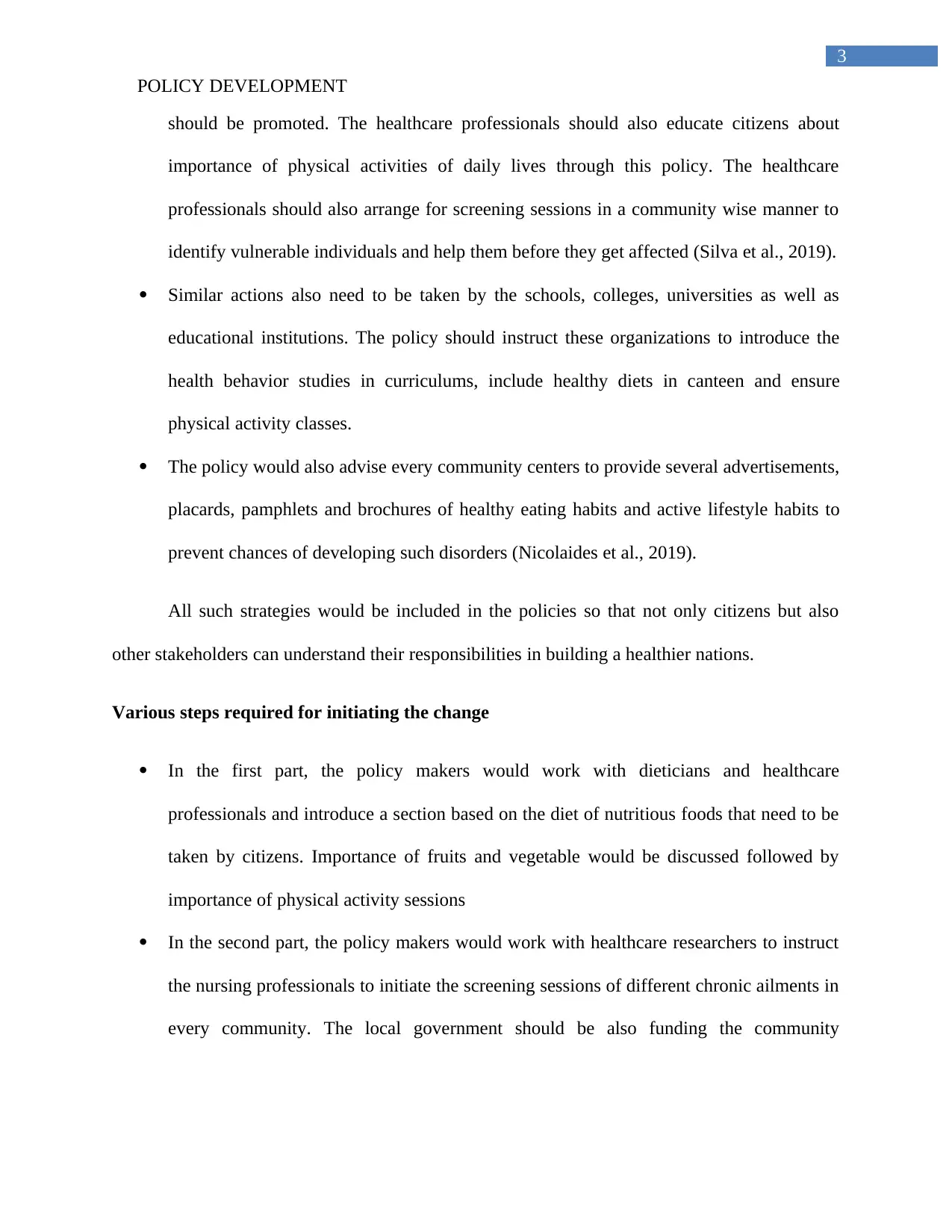
3
POLICY DEVELOPMENT
should be promoted. The healthcare professionals should also educate citizens about
importance of physical activities of daily lives through this policy. The healthcare
professionals should also arrange for screening sessions in a community wise manner to
identify vulnerable individuals and help them before they get affected (Silva et al., 2019).
Similar actions also need to be taken by the schools, colleges, universities as well as
educational institutions. The policy should instruct these organizations to introduce the
health behavior studies in curriculums, include healthy diets in canteen and ensure
physical activity classes.
The policy would also advise every community centers to provide several advertisements,
placards, pamphlets and brochures of healthy eating habits and active lifestyle habits to
prevent chances of developing such disorders (Nicolaides et al., 2019).
All such strategies would be included in the policies so that not only citizens but also
other stakeholders can understand their responsibilities in building a healthier nations.
Various steps required for initiating the change
In the first part, the policy makers would work with dieticians and healthcare
professionals and introduce a section based on the diet of nutritious foods that need to be
taken by citizens. Importance of fruits and vegetable would be discussed followed by
importance of physical activity sessions
In the second part, the policy makers would work with healthcare researchers to instruct
the nursing professionals to initiate the screening sessions of different chronic ailments in
every community. The local government should be also funding the community
POLICY DEVELOPMENT
should be promoted. The healthcare professionals should also educate citizens about
importance of physical activities of daily lives through this policy. The healthcare
professionals should also arrange for screening sessions in a community wise manner to
identify vulnerable individuals and help them before they get affected (Silva et al., 2019).
Similar actions also need to be taken by the schools, colleges, universities as well as
educational institutions. The policy should instruct these organizations to introduce the
health behavior studies in curriculums, include healthy diets in canteen and ensure
physical activity classes.
The policy would also advise every community centers to provide several advertisements,
placards, pamphlets and brochures of healthy eating habits and active lifestyle habits to
prevent chances of developing such disorders (Nicolaides et al., 2019).
All such strategies would be included in the policies so that not only citizens but also
other stakeholders can understand their responsibilities in building a healthier nations.
Various steps required for initiating the change
In the first part, the policy makers would work with dieticians and healthcare
professionals and introduce a section based on the diet of nutritious foods that need to be
taken by citizens. Importance of fruits and vegetable would be discussed followed by
importance of physical activity sessions
In the second part, the policy makers would work with healthcare researchers to instruct
the nursing professionals to initiate the screening sessions of different chronic ailments in
every community. The local government should be also funding the community
Paraphrase This Document
Need a fresh take? Get an instant paraphrase of this document with our AI Paraphraser
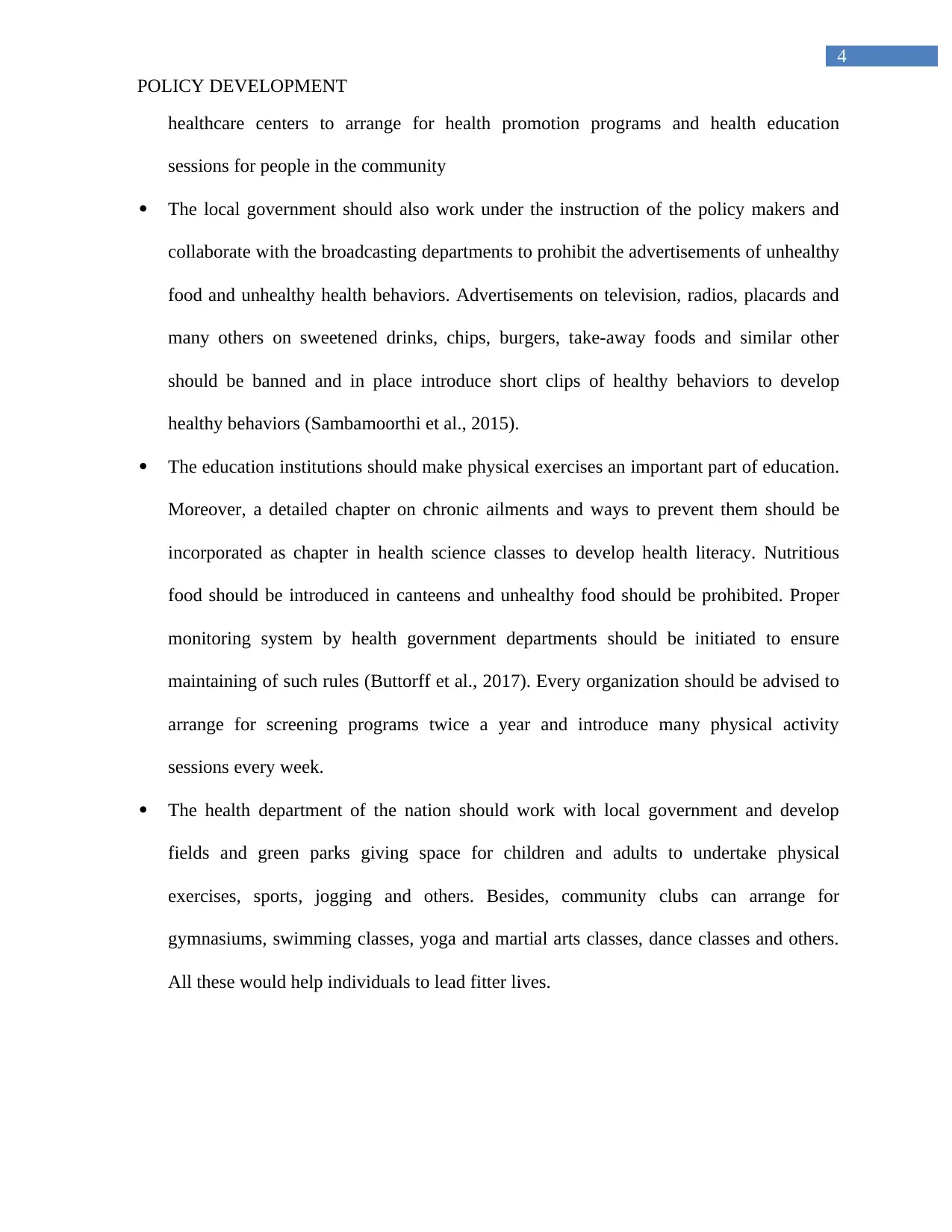
4
POLICY DEVELOPMENT
healthcare centers to arrange for health promotion programs and health education
sessions for people in the community
The local government should also work under the instruction of the policy makers and
collaborate with the broadcasting departments to prohibit the advertisements of unhealthy
food and unhealthy health behaviors. Advertisements on television, radios, placards and
many others on sweetened drinks, chips, burgers, take-away foods and similar other
should be banned and in place introduce short clips of healthy behaviors to develop
healthy behaviors (Sambamoorthi et al., 2015).
The education institutions should make physical exercises an important part of education.
Moreover, a detailed chapter on chronic ailments and ways to prevent them should be
incorporated as chapter in health science classes to develop health literacy. Nutritious
food should be introduced in canteens and unhealthy food should be prohibited. Proper
monitoring system by health government departments should be initiated to ensure
maintaining of such rules (Buttorff et al., 2017). Every organization should be advised to
arrange for screening programs twice a year and introduce many physical activity
sessions every week.
The health department of the nation should work with local government and develop
fields and green parks giving space for children and adults to undertake physical
exercises, sports, jogging and others. Besides, community clubs can arrange for
gymnasiums, swimming classes, yoga and martial arts classes, dance classes and others.
All these would help individuals to lead fitter lives.
POLICY DEVELOPMENT
healthcare centers to arrange for health promotion programs and health education
sessions for people in the community
The local government should also work under the instruction of the policy makers and
collaborate with the broadcasting departments to prohibit the advertisements of unhealthy
food and unhealthy health behaviors. Advertisements on television, radios, placards and
many others on sweetened drinks, chips, burgers, take-away foods and similar other
should be banned and in place introduce short clips of healthy behaviors to develop
healthy behaviors (Sambamoorthi et al., 2015).
The education institutions should make physical exercises an important part of education.
Moreover, a detailed chapter on chronic ailments and ways to prevent them should be
incorporated as chapter in health science classes to develop health literacy. Nutritious
food should be introduced in canteens and unhealthy food should be prohibited. Proper
monitoring system by health government departments should be initiated to ensure
maintaining of such rules (Buttorff et al., 2017). Every organization should be advised to
arrange for screening programs twice a year and introduce many physical activity
sessions every week.
The health department of the nation should work with local government and develop
fields and green parks giving space for children and adults to undertake physical
exercises, sports, jogging and others. Besides, community clubs can arrange for
gymnasiums, swimming classes, yoga and martial arts classes, dance classes and others.
All these would help individuals to lead fitter lives.
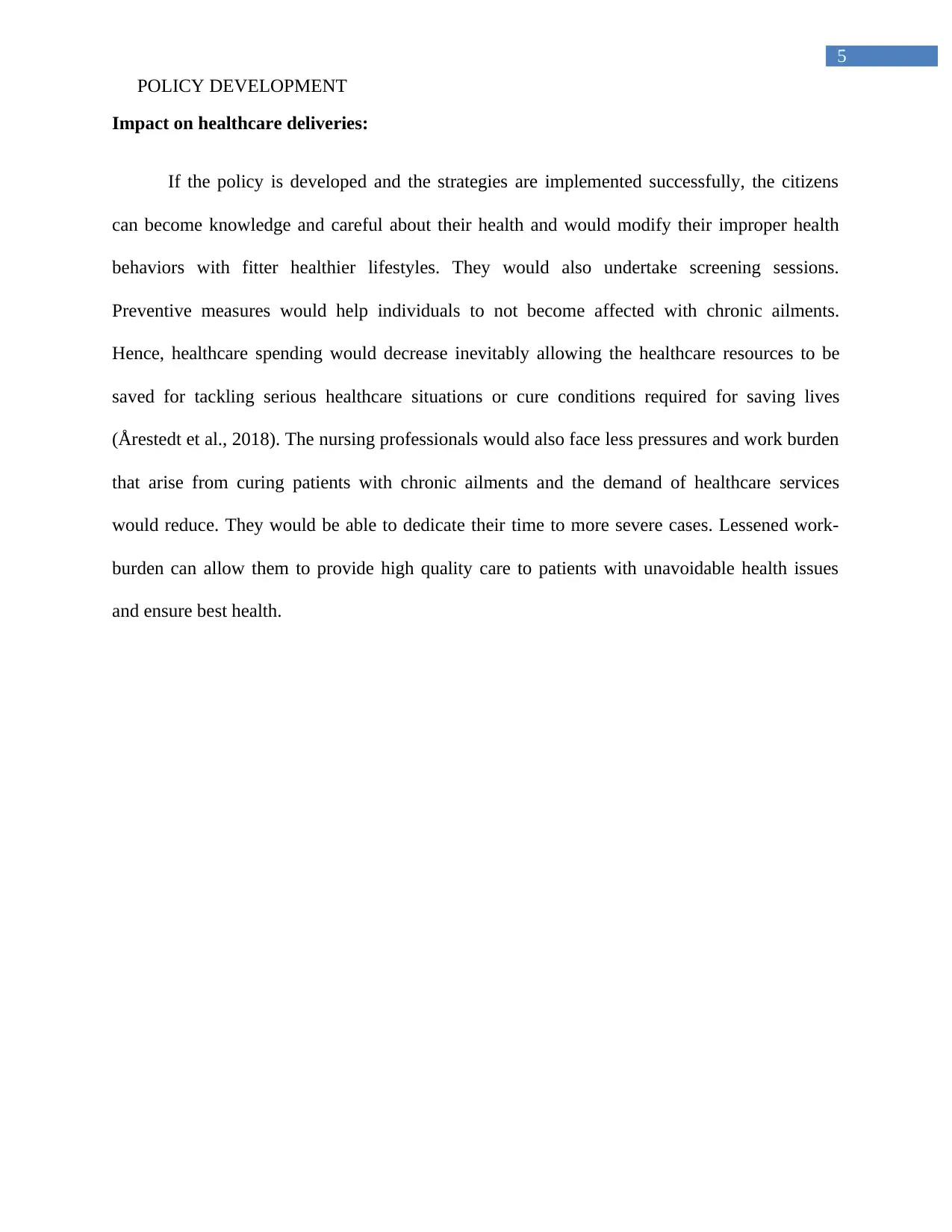
5
POLICY DEVELOPMENT
Impact on healthcare deliveries:
If the policy is developed and the strategies are implemented successfully, the citizens
can become knowledge and careful about their health and would modify their improper health
behaviors with fitter healthier lifestyles. They would also undertake screening sessions.
Preventive measures would help individuals to not become affected with chronic ailments.
Hence, healthcare spending would decrease inevitably allowing the healthcare resources to be
saved for tackling serious healthcare situations or cure conditions required for saving lives
(Årestedt et al., 2018). The nursing professionals would also face less pressures and work burden
that arise from curing patients with chronic ailments and the demand of healthcare services
would reduce. They would be able to dedicate their time to more severe cases. Lessened work-
burden can allow them to provide high quality care to patients with unavoidable health issues
and ensure best health.
POLICY DEVELOPMENT
Impact on healthcare deliveries:
If the policy is developed and the strategies are implemented successfully, the citizens
can become knowledge and careful about their health and would modify their improper health
behaviors with fitter healthier lifestyles. They would also undertake screening sessions.
Preventive measures would help individuals to not become affected with chronic ailments.
Hence, healthcare spending would decrease inevitably allowing the healthcare resources to be
saved for tackling serious healthcare situations or cure conditions required for saving lives
(Årestedt et al., 2018). The nursing professionals would also face less pressures and work burden
that arise from curing patients with chronic ailments and the demand of healthcare services
would reduce. They would be able to dedicate their time to more severe cases. Lessened work-
burden can allow them to provide high quality care to patients with unavoidable health issues
and ensure best health.
⊘ This is a preview!⊘
Do you want full access?
Subscribe today to unlock all pages.

Trusted by 1+ million students worldwide
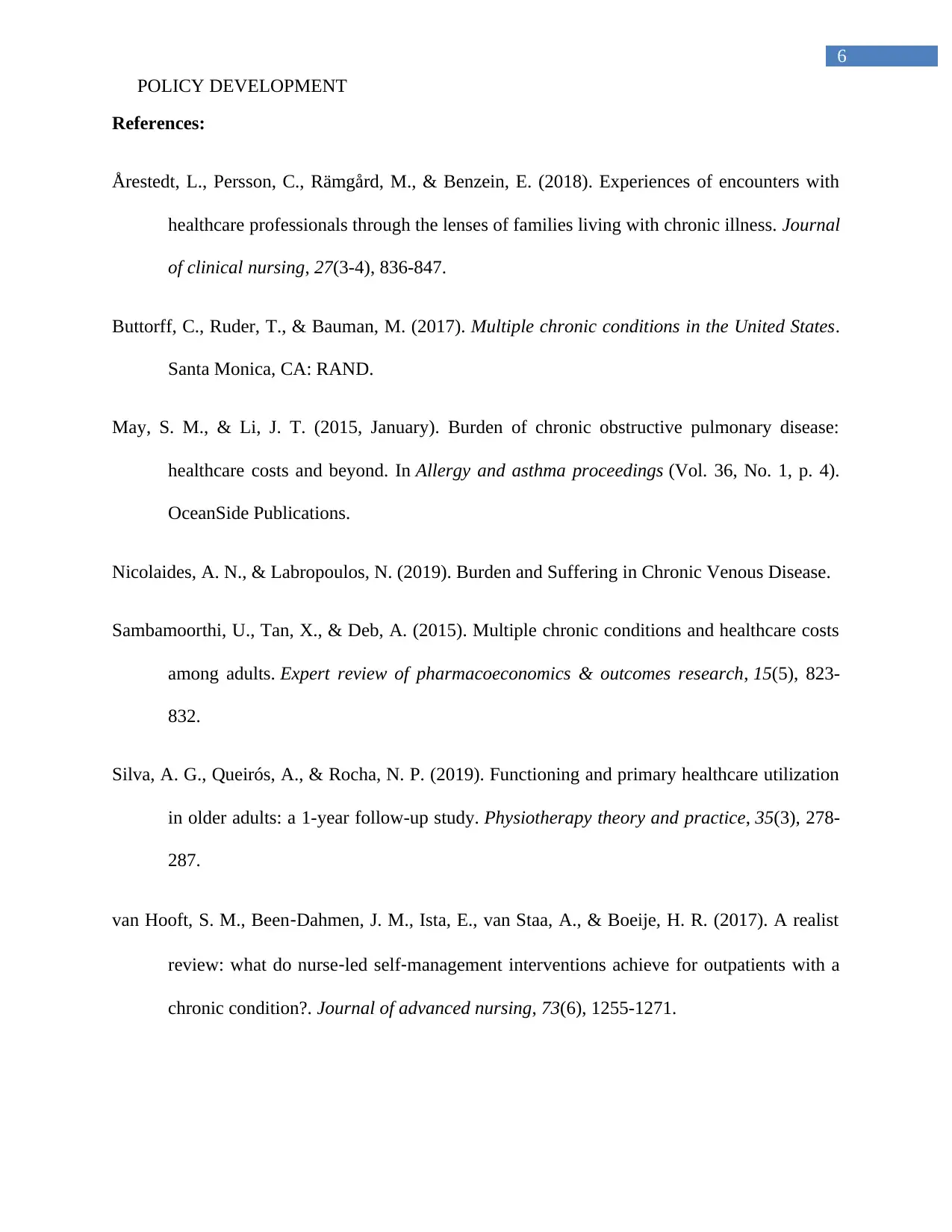
6
POLICY DEVELOPMENT
References:
Årestedt, L., Persson, C., Rämgård, M., & Benzein, E. (2018). Experiences of encounters with
healthcare professionals through the lenses of families living with chronic illness. Journal
of clinical nursing, 27(3-4), 836-847.
Buttorff, C., Ruder, T., & Bauman, M. (2017). Multiple chronic conditions in the United States.
Santa Monica, CA: RAND.
May, S. M., & Li, J. T. (2015, January). Burden of chronic obstructive pulmonary disease:
healthcare costs and beyond. In Allergy and asthma proceedings (Vol. 36, No. 1, p. 4).
OceanSide Publications.
Nicolaides, A. N., & Labropoulos, N. (2019). Burden and Suffering in Chronic Venous Disease.
Sambamoorthi, U., Tan, X., & Deb, A. (2015). Multiple chronic conditions and healthcare costs
among adults. Expert review of pharmacoeconomics & outcomes research, 15(5), 823-
832.
Silva, A. G., Queirós, A., & Rocha, N. P. (2019). Functioning and primary healthcare utilization
in older adults: a 1-year follow-up study. Physiotherapy theory and practice, 35(3), 278-
287.
van Hooft, S. M., Been‐Dahmen, J. M., Ista, E., van Staa, A., & Boeije, H. R. (2017). A realist
review: what do nurse‐led self‐management interventions achieve for outpatients with a
chronic condition?. Journal of advanced nursing, 73(6), 1255-1271.
POLICY DEVELOPMENT
References:
Årestedt, L., Persson, C., Rämgård, M., & Benzein, E. (2018). Experiences of encounters with
healthcare professionals through the lenses of families living with chronic illness. Journal
of clinical nursing, 27(3-4), 836-847.
Buttorff, C., Ruder, T., & Bauman, M. (2017). Multiple chronic conditions in the United States.
Santa Monica, CA: RAND.
May, S. M., & Li, J. T. (2015, January). Burden of chronic obstructive pulmonary disease:
healthcare costs and beyond. In Allergy and asthma proceedings (Vol. 36, No. 1, p. 4).
OceanSide Publications.
Nicolaides, A. N., & Labropoulos, N. (2019). Burden and Suffering in Chronic Venous Disease.
Sambamoorthi, U., Tan, X., & Deb, A. (2015). Multiple chronic conditions and healthcare costs
among adults. Expert review of pharmacoeconomics & outcomes research, 15(5), 823-
832.
Silva, A. G., Queirós, A., & Rocha, N. P. (2019). Functioning and primary healthcare utilization
in older adults: a 1-year follow-up study. Physiotherapy theory and practice, 35(3), 278-
287.
van Hooft, S. M., Been‐Dahmen, J. M., Ista, E., van Staa, A., & Boeije, H. R. (2017). A realist
review: what do nurse‐led self‐management interventions achieve for outpatients with a
chronic condition?. Journal of advanced nursing, 73(6), 1255-1271.
Paraphrase This Document
Need a fresh take? Get an instant paraphrase of this document with our AI Paraphraser
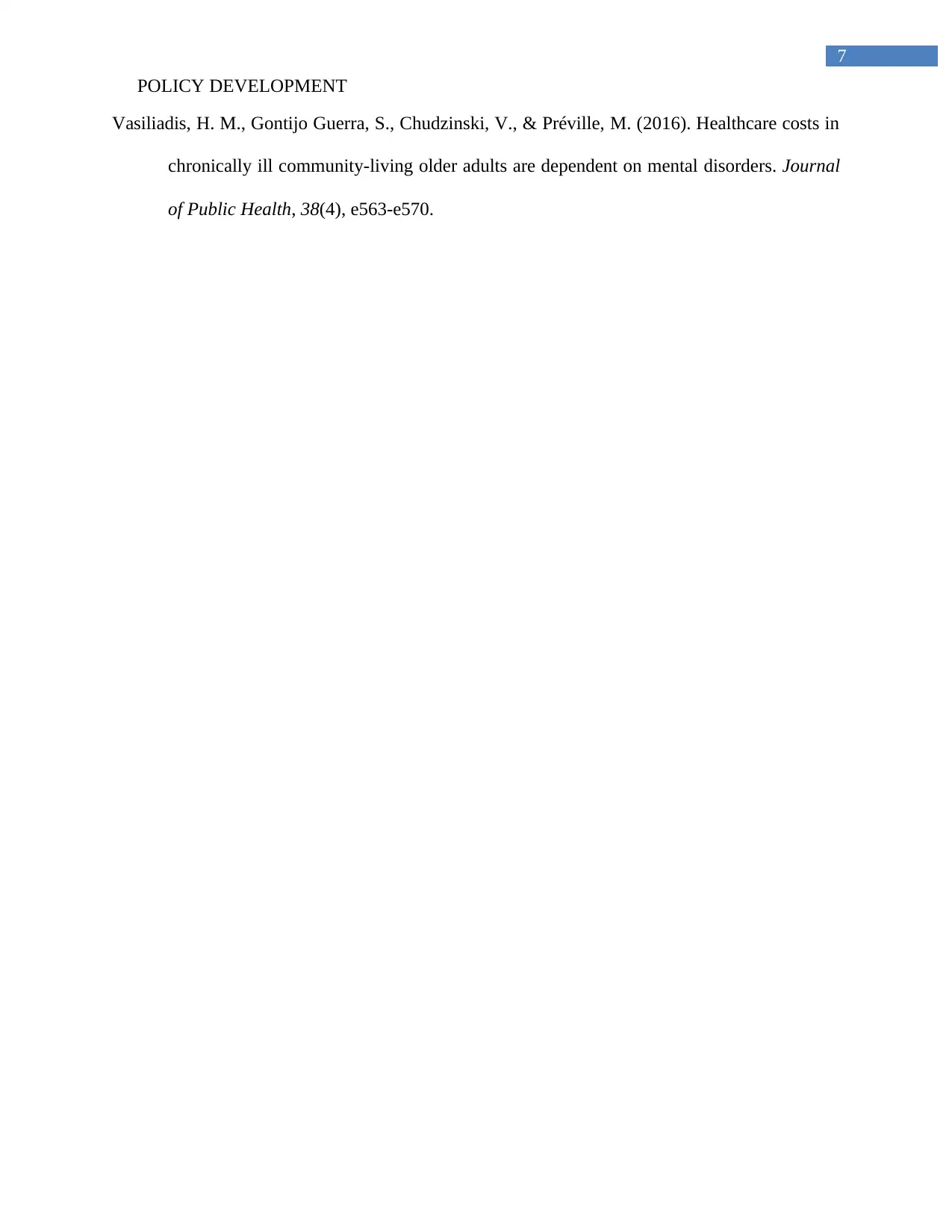
7
POLICY DEVELOPMENT
Vasiliadis, H. M., Gontijo Guerra, S., Chudzinski, V., & Préville, M. (2016). Healthcare costs in
chronically ill community-living older adults are dependent on mental disorders. Journal
of Public Health, 38(4), e563-e570.
POLICY DEVELOPMENT
Vasiliadis, H. M., Gontijo Guerra, S., Chudzinski, V., & Préville, M. (2016). Healthcare costs in
chronically ill community-living older adults are dependent on mental disorders. Journal
of Public Health, 38(4), e563-e570.
1 out of 8
Related Documents
Your All-in-One AI-Powered Toolkit for Academic Success.
+13062052269
info@desklib.com
Available 24*7 on WhatsApp / Email
![[object Object]](/_next/static/media/star-bottom.7253800d.svg)
Unlock your academic potential
Copyright © 2020–2025 A2Z Services. All Rights Reserved. Developed and managed by ZUCOL.





